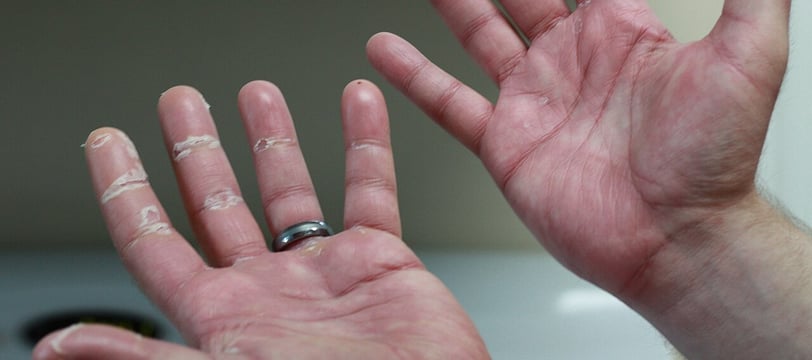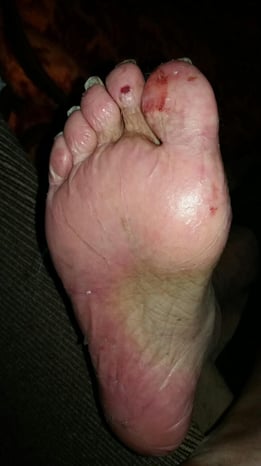Hand-Foot Syndrome: Causes, Symptoms, and Treatment
Hand-Foot Syndrome (HFS), also known as Palmar-Plantar Erythrodysesthesia, is a dermatologic condition primarily caused by chemotherapy drugs. It manifests as redness, swelling, and pain in the hands and feet, significantly affecting a patient’s quality of life. Understanding the causes, symptoms, and available treatments can help manage this condition effectively.
ONCOLOGYPODIATRY
Rishwin A R
1/31/20252 min read


Causes of Hand-Foot Syndrome
HFS occurs due to the leakage of chemotherapy drugs from capillaries in the hands and feet. This leads to direct toxicity, causing inflammation and skin damage. The most common chemotherapy drugs associated with HFS include:
Cabozantinib
Fluorouracil
Capecitabine
Doxorubicin (liposomal form)
Cytarabine
Docetaxel and Paclitaxel
The condition arises because the hands and feet have increased friction, pressure, and temperature changes, making them more susceptible to drug accumulation.
Symptoms of Hand-Foot Syndrome
The severity of HFS varies, ranging from mild discomfort to severe pain and functional impairment. Symptoms generally include:
Mild Symptoms:
Redness (erythema)
Tingling or numbness
Mild swelling
Skin sensitivity
Moderate Symptoms:
Increased pain or burning sensation
Peeling or blistering of the skin
Difficulty in performing daily activities
Severe Symptoms:
Intense pain and swelling
Deep skin cracks (fissures)
Open sores or ulcers
Difficulty walking or using hands


Image Source: Wikimedia Commons | Author: Natasa R | License: CC BY-SA 4.0
Diagnosis
HFS is diagnosed clinically based on symptoms and history of chemotherapy use. No specific lab tests are required, but physicians may perform a skin biopsy in rare cases to rule out other conditions like severe allergic reactions or infections.
Treatment and Management
Currently, no definitive cure exists for HFS, but several strategies can help manage and reduce symptoms effectively:
1. Dose Modification of Chemotherapy
Lowering the dosage or temporarily stopping chemotherapy may prevent worsening symptoms.
Consulting an oncologist about alternative medications can be beneficial.
2. Symptomatic Relief
Topical corticosteroids: Reduce inflammation and discomfort.
Moisturizers: Hydrates the skin and prevents dryness.
Pain relievers (NSAIDs or acetaminophen): Alleviates pain and swelling.
3. Lifestyle Modifications
Avoid excessive heat: Hot water can worsen symptoms; opt for lukewarm baths.
Minimize friction and pressure: Wear soft shoes, padded gloves, and avoid tight footwear.
Use cold compresses: Helps in reducing inflammation and discomfort.
4. Nutritional Support
Increase intake of Vitamin B6 (Pyridoxine), as it may help in reducing symptoms.
Stay hydrated to improve skin elasticity and overall health.
Prevention Strategies
While HFS may not always be preventable, certain measures can help minimize its severity:
Apply cooling pads to hands and feet during chemotherapy.
Use thick emollient creams before bed to lock in moisture.
Avoid prolonged standing, walking, or manual work that causes excess pressure.
Conclusion
Hand-Foot Syndrome is a challenging side effect of chemotherapy, but with proper management, patients can maintain a good quality of life. Early intervention, lifestyle adjustments, and medication strategies play a crucial role in reducing discomfort and preventing complications.
FAQs
1. Is Hand-Foot Syndrome permanent?
No, symptoms typically resolve after chemotherapy is discontinued or modified.
2. Can Hand-Foot Syndrome occur without chemotherapy?
While rare, certain non-chemotherapy medications like tyrosine kinase inhibitors can also cause HFS.
3. What are the best home remedies for HFS?
Applying cold compresses, using thick moisturizers, and avoiding friction-heavy activities can help relieve symptoms.
4. How long does it take for HFS symptoms to improve?
Mild cases may improve within a few weeks after treatment adjustments, while severe cases may take longer.
5. Can I continue chemotherapy if I have HFS?
It depends on the severity of symptoms. Your oncologist may adjust your dosage or provide supportive treatments to help manage side effects.
Syndromes.xyz
Explore medical syndromes and their details here.
For Educational purposes only
The information on this site is not in any way, replacement for professional advice. Always consult your physician regarding personal queries
Connect
Support
syndromesxyz@gmail.com
© 2024. All rights reserved.
